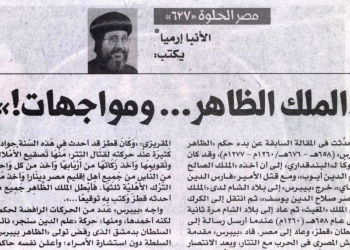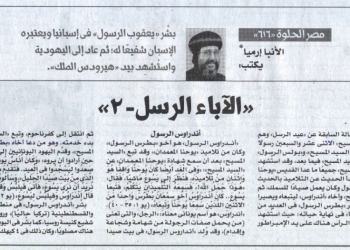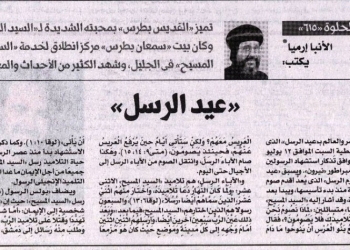Armenia is split into two sections: Greater Armenia (Armenia Major) eastwards and Lesser Armenia (Armenia Minor) westwards. It was called Hayk in ancient times: for it is a highland which highest mountain chain is Ararat. Several rivers run through it, such, Tigris, Euphrates, Araks, Akhurian, Vorotan and others. Nowadays, it is called the Armenian Highland. It ranges from 850 to 1850 meters above the sea level. Its area is 250 thousand square meters. It is bordered by Euphrates from the west, the Pontic Mountains, Georgia, the Caucasus Mountains from the north, Azerbaijan and Iran from the east, and Taurus Mountains, the lowland and Iraq from the south. Originally, the Armenians are Indo-Europeans. Armenia is the first state to declare Christianity her official religion in 301 A.D.
In like manner Copts went through persecution, Armenians were persecuted. Armenian Massacres were also known as the Armenian Genocide and the Armenian Holocaust.
The start was between 1894-1896. It was known as the Hamidian massacre. Christian villages were attacked and hundreds of thousands of Greeks, Armenians and Assyrians were killed. In 1909, massacres were resumed in Cilicia and Adana where 30 thousand Armenians were butchered.
Yet, the worst of Armenian massacres took place during World War I: for they were deported and killed in one of history’s most horrific mass murders, which is why it came second after the Holocaust.
On April 24, 1915, which became a commemoration of the Armenian Genocide, hundreds of Armenian elites, feudalists and clergymen were arrested and executed right in the city’s public squares, after which Armenians were deported from their towns and villages in caravans that can be described as “death processions”. Men were killed and burnt. Women, children, and elderly were imprisoned and deported in deserted roads. They were taken to Deir ez-Zor where they were left hungry and thirsty, just to die miserably. The people of Deir ez-Zor used to hide the children and adults who were able to flee. Whenever they were asked about the children, they used to deny seeing them and claim they were their own.
Researchers believe that the Armenian victims amounted to one and a half million people. Yet, this was not the Armenians’ fate only: for entire Christian ethnic groups were exterminated like Syriacs, Assyrians, Chaldeans, Greeks and others.
In 1915, the U.S. Ambassador to Istanbul commented on the sight of Armenian corpses in the streets, saying, “Such sights spread wherever Armenians lived during the Spring and Summer of 1915. People were put to death in various ways, namely, massacres, famines, and deportation which harmed the majority of the refugees. The Turkish policy decreed public extermination and exile.”
An American correspondent to Osroene recounts the following, “We watched atrocities perpetrated unto thousands within six weeks. These people had come from northern cities to cross ours. All of them tell the same story: Their men were killed on the first day after women and girls had been beaten or kidnapped. Some of them were kidnapped by their guards who were the worst creatures ever. They allowed inhabitants of the villages they passed by to seize women and rape them. This is no fiction. We saw it with our own eyes happening in the streets.”
In an interview with the “Independent” the 101-year survivor Yevnige Salibian recounts how close to the Holocaust the Armenian genocide was. Here, it is worthy to point out that though Turkey insists on denying the Ottoman Empire’s extermination one million and a half Armenians a century ago, either by gunshot, stabbing, or beating by axes. Children were sent to the woods northern Syria. They were starved, raped, and slaughtered. Salibian asserts that at the beginning, her family was not deported due to her father’s engagement in commerce. Yet, she remembers children’s screaming and crying as they were taken barefoot, and the soldiers used to flog them in order to leave the place!
Zakar Berberyan, an 89-year-old blind elderly man recounts his memories, saying, “In 1915, I was 12. I lived in the village of Bilecik by the Euphrates. I had four brothers. My dad was a barber. On that day, I saw Turkish soldiers invading our village. I shall never forget that sight. I had not lost my eyesight, then. They burnt Bilecik marketplace, and stones of buildings flew everywhere. Women and children were dragged to the old marketplace. The soldiers would snatch children of all ages and throw them on the ground that they might die before their mothers, no matter how old they were: fix, six, or eight years old. If they did not die because of the fall, they would be shot, or stoned. This was done before the mothers. Never in my life did I hear mothers cry this way. I saw all this from my father’s shop. Mothers could do nothing but scream and wail. One of those children was a schoolmate. They found his exam report in his pocket and that he got excellent marks. So, they blew his head up. A Turkish soldier tied one of my friends’ feet to his horse’s tail and dragged him through the village until he died!”
The December 15 Issue of the “New York Times”, we read that about a million people were killed or banished by the Turks. Also, because of these massacres, Armenians migrated to many countries, such as, Syria, Lebanon, Egypt, and Iraq.
On June 15, 2005, the Deutscher Bundestag issued a resolution to honor the Armenian victims of violence, murder, and deportation prior and during World War I whereby, “The Deutscher Bundestag does hereby declare its resentment at the Ottoman Empire’s extermination of entire Armenian communities in Anatolia, as well as the Reich’s not confronting such atrocities.”
Egypt’s Stance
Egypt has always been humane with the entire world. She received Armenian deportees, who amounted to 2000 refugees from 1894 to 1896. Egyptian writers, like Mustafa Lutfy al-Manfaluti, Ahmed Lufty al-Sayed, and others rebuked the atrocities perpetrated in Adana. Also, the Grand Imam of al-Azhar, Sheikh Salim al-Bishri, issued a “fatwa” that admonished the massacres against Christians. About 4000 Armenians took refuge in Port Said in 1915 until their return in 1919. Additionally Sa’d Zaghloul allowed Armenian orphans to resort to the Armenian Archdiocese: for they were more than 1000 children. Likewise, Egypt was the first country to publish a book that documents the Armenian Genocide. It was edited by the Ottoman lawyer and civil servant Fa’ez al-Ghussein. The first edition was published after he had helped its writer reach the country to recount what happened to Armenians: for stories never end in Beautiful Egypt.
General Bishop
Head of the Coptic Orthodox Cultural Center


 العربية
العربية











